PURPOSE Recreation specialization theory, which is characterized by a unique development process and progress, has been found to have varied pathways that develop in different patterns based on each dimension of recreation specialization. This study aimed to investigate how each sub-dimension of specialization changes as the degrees of experiential participation (frequency, period, and intensity of participation) and goods investment (expenditure) of the scuba divers increase. METHODS In the summer of 2021 (May-August), a purposive sampling method was used to collect samples from young scuba divers, and 278 copies of valid data were used for the final analysis. Frequency analysis, descriptive statistical analysis, confirmatory factor analysis, reliability analysis, correlation analysis, curve estimation analysis, and hierarchical regression analysis were performed using SPSS 24.0 and AMOS 24.0 ver. RESULTS The findings were as follows. First, the quadratic nonlinear model was identified as the optimal model for the relationships between the scuba divers’ participation intensity and cognitive, behavioral, and affective recreation specializations based on experience. Second, the cubic nonlinear model was identified as the optimal model for the relationships between the participation period, frequency of participation, and cognitive, behavioral, and affective recreation specializations of scuba divers. Third, the cubic nonlinear model was identified as the optimal model for the relationships between the expenditure cost of scuba divers and the cognitive, behavioral, and affective recreation specializations in the center of the goods. As the period, frequency, and expenditure of scuba diving participants increased, the relevant cognitive, behavioral, and affective specializations did not progress in a linear manner; instead, they went through an intermediate maintenance stage and developed to a higher level. CONCLUSIONS Progressive and meaningful consumption of experiences and goods further promotes recreation specialization. Any future follow-up study should identify a trade-off point in the development of the recreation specialization in a step by step manner.
PURPOSE This study aims to analyze research trends on the social capital in sports. METHODS A total of 69 papers published until December 2020 were selected as research subjects. Further, Excel, KrKwic software, and NetDraw function of the UCINET 6 program were used for analysis. RESULTS First, social capital research on sports has shown quantitative growth since 2010. Second, the studies were conducted on sports participants such as general, elderly, college students, adolescents, foreigners, and the disabled, showing the highest frequency of research subjects. Third, quantitative research conducted based on the research method were several. Fourth, single-author studies were the highest. Fifth, as the result of the analysis on the publication journal, the Journal of the Korean Physical Education Association was shown the highest. Sixth, due to frequency analysis of the thesis keywords, “social capital,” “sports participation,” “action intention,” “social capital type,” “living sports participation,” and “youth” were shown the highest. Seventh, as a result of centrality analysis between keywords through the network analysis, “sports participation” in connection centrality, “health-promoting lifestyle” in proximity centrality, and “sports participation” in mediation centrality were found as the highest. CONCLUSIONS The significance of social capital in sports is more important than others because it is a fundamental element for creating a culture where more people can enjoy sports moderately in Korea, where capitalism and liberal democracy were adopted as the governing system. Therefore, this study can be a vital resource significantly contributing to the understanding and active use of social capital, a significant factor in developing sports in Korea.
Impact of 9-week strength training of racing cyclist candidate during training camp on body composition, racing cyclist specific fitness, and racing cycle performance was examined. Two by two (cyclist experience, y/n and strength training (ST) participation, y/n) experiment design was employed. A total of 20 candidates participated and divided evenly into four groups; 1) experienced cyclist participating ST (CST), 2) non-experience cyclist participating ST (nCST), 3) experienced cyclist no participating ST (CnST), and 4) non-experience cyclist no participating ST (nCnST). Two programs were introduced; 1) non ST containing, pre-existing program emphasizing on sprint and acceleration training and 2) new-program containing ST and sprint and acceleration training. CST and nCST participated the latter program. Before and after the 9-week training, body composition, racing cyclist specific fitness, and racing cycle performance was tested. After 9 weeks, all groups decreased body weight(p<0.05), body fat content(p<0.05), body mass index, and CST and nCST increased lean body mass(p<0.05). Muscular strength measures such as grip strength, low back strength, 1RM of bench press, 1RM of squat, and anaerobic capacity improved after 9 weeks in all groups(p<0.05). The magnitude of changes was greater in order of CST, nCST, CnST, nCnST. Time trial of 200 meter sprint was faster after 9 weeks in all groups except CnST while 500 meter sprint was improved only in nCnST(p<0.05). After 9 weeks, regardless of previous cyclist experience, those who participated in ST ranked high places at racing cycle competition. Both training programs for the candidates improved body composition and racing cyclist specific fitness. When strength training was added to pre-existing training program emphasized on sprint and acceleration, the racing cycle performance was enhanced. Strength training for racing cyclist is highly recommended to improve their racing performance.
PURPOSE This study aimed to understand the changes in the exercise behavior of participants in the exercise-psychological counseling program. METHODS This study sampled adult female participants of C diet camp in Seoul, who were in stages 2~3 of the “Stages of Change Model.” A total of 60 participants were randomly assigned to the counseling group (n=30) and control group (n=30). During the 12 weeks of study, all subjects participated in the diet camp program C. The counseling group participated in the exercise psychological counseling program once a week, while the control group participated in recreational activities instead. Exercise adherence, outcome-expectancy, and satisfaction were measured once every four weeks. Latent growth models were used to analyze the measured data. RESULTS Exercise adherence, outcome-expectancy, and satisfaction in the counseling group exerted a statistically significant positive effect. A statistically significant positive effect on the change of exercise adherence variable was observed in the control group, but the trend was only 1/4 of that of the counseling group. In the control group, exercise outcome-expectancy and exercise satisfaction did not have a statistically significant outcome. CONCLUSIONS The exercise counseling program is an essential intervention strategy that enhances participants’ exercise adherence, outcome-expectancy, and satisfaction. Therefore, a positive change in exercise behaviors occurs.
PURPOSE The purpose of this study was to apply a life skills program to student-athletes and statistically verify the changes in life skills of the experimental and control group. METHODS Participants were 34 high school Taekwondo athletes (Mage=17.71). They were divided into 18 in the experimental group and 16 in the control group. For eight weeks, the experimental group participated in the life skills program after training and the control group participated in only training as usual. Data were collected by using Life Skills Scale for Student-Athletes (LSSSA), and the participants of two groups filled out the LSSSA before and after the program application. The collected data were analyzed by using repeated measure analysis of variance (ANOVA), and partial η2 (eta squared) was calculated to present the effect size. RESULTS The interaction between time and group was statistically significant in goal setting, coping with stress, positive thinking, and managing emotion among sub-factors of life skills. Partial η2 was interpreted as having a large effect size as it revealed the range of .22 to .51. Therefore, comparing before and after participating in the program, the life skills score of the experimental group among the two groups was significantly improved. CONCLUSIONS Student-athletes who participated in the program experienced positive changes in life skills than those who did not participate in the program.
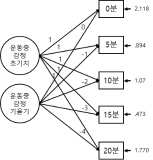
Recent research on exercise and affect has examined participants` affective changes during and after exercise with a longitudinal approach. With regard to this viewpoint, a theoretical model (Dual Mode model) has been presented to explain the different change of affect in an exercise setting and the model identified the impact of psychological factors on the affective changes. However, not only there is little empirical studies on the dual-mode model, but some relevant research has used an inappropriate statistical method (ANOVA), which cannot effectively explain the overall trends in affective change during and after exercise. Exiting research has a limitation to generalize the DM model examining only a certain gender such as active male or inactive female participants. Thus, the aim of present study was to investigate the effect of intrinsic motivation on affective change during and after exercise in participants who do not take part in regular exercise considering gender based difference. 51 inactive university students (M: 36, F: 15) responded a survey measuring intrinsic motivation for running activity and participated in moderate-intensity running exercise to examine affective change during exercise. Therefore, present study examined the influence of intrinsic motivation as a psychological variable on the trend of affective changes during and after exercise based on the dual mode model. Results from the latent curve model analysis revealed that there were decreasing trends of affect during exercise and the trends were individually different. Importantly, the decreasing trends were weaker in the participants with higher intrinsic motivation[FL=-.34, p=.000]. Additionally, participants` affective responses were positively changed after the exercise in general, but the changes were not influenced by intrinsic motivation. Therefore, the decreasing trend of affective change during exercise was weaker in the participants with higher intrinsic motivation, and the positive change in affect after exercise was not influenced by intrinsic motivation.

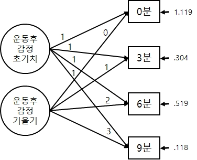
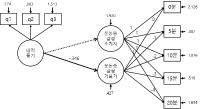


The purpose of this study is to examine acculturation strategies of expatriates in Korea in relation to spectator sport involvement. Berry's(1997) bi-dimensional model of acculturation was used as a theoretical framework to categorize the type of acculturation strategies of expatriates in Korea. Acculturation strategies of expatriates were classified into four types: integration, assimilation, separation, and marginalization. To be specific, there were 79 participants using the integration strategy, 28 using the assimilation strategy, 53 using the separation strategy, and 20 using the marginalization strategy. Research hypotheses were established to analyze differences on spectator sport involvement of expatriates between Korean spectator sport and their original cultural sport. There were significant differences in spectator sport involvement among foreigners in Korea. Firstly, the spectator sport involvement of the participants using the integration strategy was higher than that of marginalization. Second, participants categorized as using assimilation strategy were found to have lower sport involvement with Korea's spectator sport and had a higher involvement with their original cultural sport. Third, participants categorized as using separation strategy were found to have higher involvement with their original cultural sport than Korea's. Fourth, participants categorized as using separation strategy did not show significant differences with assimilation participants in comparing original cultural spectator sport. In conclusion, the result of the research indicated that expatriates living in Korea showed similar characteristics of Berry's (1997) acculturation strategies. Thus, It indicated that Berry's (1997) acculturation strategies are useful theoretical tools predicting psychological preference of expatriates in Korea. However, participants showed little difference in that all expatriates of four categories showed higher involvement with their original cultural spectator sport. Therefore, unlike Berry's (1997) theory, people with high level of acculturation showed higher levels of involvement with their original cultural spectator sport. It may provide useful information for Korean sport marketers regarding s foreign sport consumers in order to develop a market.

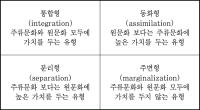
PURPOSE This study examined the cultural experiences of tennis club members that have changed due to COVID-19, specifically emphasizing the accepted culture within these clubs. METHODS Seven tennis club members, with over five years of experience, active participation in two or more clubs, and a history of active participation, were interviewed using in-depth interviews and a semi-structured questionnaire. RESULTS Firstly, the tennis club members accepted the “no contact” culture that has emerged since COVID-19. Secondly, social distancing made getting together in large groups difficult, and tennis club activities became more limited. This has led to weakening the tennis club community, which is different from what we have seen before. Lastly, the growing interest in non-traditional content has led to an increase in participants enjoying tennis through social media. The information and experiences gained through social media have changed the perception of coaching. CONCLUSIONS The cultures that tennis players have adopted due to COVID-19 are expected to continue in the future. The findings from this study may provide evidence for understanding the changing culture of sports in the future.

Purpose The goal of this study was to investigate the application effect of strength-based positive psychology intervention to elite archers. Methods Total of 20 elite archers participated in this study. Treatment group consisted of 10 elite archers participated in the strength-based positive psychology intervention for 8 weeks. Each individual responded the questionnaires in pre- and post-treatment sessions. Data were analyzed by repeated-measure ANOVA. Furthermore, archers participated in the program responded to in-depth interviews. Results According to the results, participants in strength-based positive psychology intervention showed that significantly increased strength knowledge, strength use, and optimism in the post–treatment compared to the pre-treatment session while control group did not show significant changes. In addition, archers perceived that there were positive effect on thinking ·coping and their self-confidence and self-esteem enhanced after participating the program. Conclusion The results of this study suggested that strength-based positive psychology intervention has positive impact on athlete’s wellbeing and perception of individuals strength and can be applicable to different sports field.

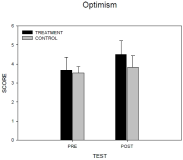
The purpose of this study was to describe psychological changes and variables of injured elite athletes during sport injury rehabilitation. 5 injured elite athletes were selected as participants, and open-ended questionnaires, participant observation, and in-depth interview were used for collecting data. Results from the data were analyzed through transcription, coding, and categorization with inductive method. To validate the results of this study, triangulation, in-depth description, member checks, and peer debriefing were used, and findings of this study were as follow. The participants showed negative psychological state such as fear of return to play and anxiety during the initial rehabilitation program, but their psychological state was changed positively such as recovery of confidence and desire of return to play at the end of program. However, the specific psychological changes of each participant showed several differences according to participant's surrounding environment and situation during the rehabilitation program. All findings have important implications for implementing and developing rehabilitation program, so needs to be investigated further.